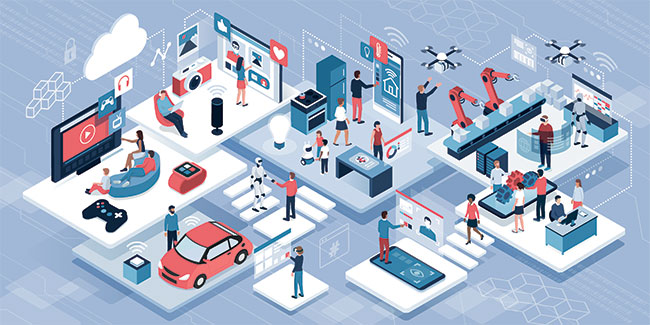SPONSORED CONTENT
The Internet of Things (IoT) has led to unprecedented access into and intimate understanding of human behaviors. There are billions of devices gathering trillions of useful data insights into consumers’ wants and needs in everyday life. Everything from relatively mundane tasks to the mapping of entire human genomes are being collected, categorized and stored as massive data pools every second of the day. These data pools are accessed by smart-device intermediaries that serve as the conduit for which companies can provide a more customized experience to their consumers, at scale. There has never been a more luminous time for the insights industry to explore such vast amounts of untapped data pools of human behavior.
 In the world of big data as it relates to the insights industry, IoT is one of those transformational forces that will shape the future of the business in 2020 and beyond. As businesses seek opportunities to deliver dynamic and customized experiences to their customers, many firms in the insights industry see big opportunity in IoT uses to unlock the promise to enhance customer relationships and drive business growth by improving quality, productivity and reliability while reducing costs and project risks.
In the world of big data as it relates to the insights industry, IoT is one of those transformational forces that will shape the future of the business in 2020 and beyond. As businesses seek opportunities to deliver dynamic and customized experiences to their customers, many firms in the insights industry see big opportunity in IoT uses to unlock the promise to enhance customer relationships and drive business growth by improving quality, productivity and reliability while reducing costs and project risks.
With all this in mind, some might question whether qualitative research is still necessary. Qualitative research has always been a small part of the market research industry compared to quantitative research. However, qual still has a place in the research toolkit. In addition to its stand-alone role of generating deep consumer insight, qual has always fulfilled an additional and fundamental role – delivering the “why” behind quantitative research and data trends. By having the right IoT model coupled with qualitative and quantitative best practices, companies will be rewarded with new customers, better insights and improved customer satisfaction, to mention just a few benefits.
Let’s explore some of the trends of IoT impacting the insights industry and technology in 2020:
1. The convergence of blockchain and IoT
Blockchain is more than a concept now and has applications in many verticals – most notably fintech – including IoT. Blockchain technology is considered by many experts as the missing link to settling scalability, privacy and reliability concerns in IoT. Blockchain technology can be used in tracking billions of connected devices; enables the processing of transactions and coordination between devices; and allows for significant savings to insights industry researchers. This decentralized approach would eliminate single points of failure in data collection and validation, creating a more resilient ecosystem for research to be conducted. The cryptographic algorithms used by blockchain would make consumer data more private. In 2020 IoT will converge with blockchain for better security and privacy, opening the door for a new category in applications, hardware and respondent talents.
2. Many mobile moments as a result of IoT
IoT is creating new opportunities and providing a competitive advantage for businesses in current and new markets. It touches everything – not just the data but also how, when, where and why you collect it. The technologies that have created the Internet of Things aren’t changing the internet only but are changing the things connected to the internet. More mobile moments (the moments in which a person pulls out a mobile device to get what he or she wants, immediately and in context) will appear on the connected device, right from home appliances to cars to smartwatches and virtual assistants. All these connected devices will have the potential of offering a rich stream of data that will then be used by the insights industry to help product and service owners find and dive deeper into the data to uncover the hidden answers that will help them improve they how interact with their consumers.
3. Containers, IoT and artificial intelligence.
In an IoT situation, AI can help companies take the billions of data points they have and boil them down to what’s really meaningful. The general premise is the same as in the retail applications – review and analyze the data you’ve collected to find patterns or similarities that can be learned from so that better decisions can be made.
The year 2020 will see IoT software being distributed across cloud services, edge devices and gateways. The year will also witness IoT solutions being built on modern microservices, an approach to application development in which a large application is built as a suite of modular services. Each module supports a specific business goal and uses a simple, well-defined interface to communicate with other modules. These solutions will also be built on containers (lightweight virtualization) that would work across this distributed architecture. Further, machine-learning cloud services and artificial intelligence will mine the data that comes in from IoT devices.
4. IoT and connectivity
Connecting the different parts of IoT to the sensors can be done using different technologies including Wi-Fi, Bluetooth, low power Wi-Fi , Wi-Max, regular ethernet, Long Term Evolution (LTE) and the recent promising technology of Li-Fi (using light as a medium of communication between the different parts of a typical network including sensors). This allows for a dependable, scalable, ubiquitous and cost-effective solution for companies who want a rapid deployment of robust appliances that can be used to capture data on- or off-site.
5. Talent shortage in IoT
Organizations launching IoT projects face a tougher time in recruiting talent. Complicating matters is that it remains a challenge to find enough workers to secure IoT. Most companies engaged in IoT struggle to find security professionals and others are having difficulty finding digital insights professionals who understand the digital landscape. In 2020, major industry vendors will invest in IoT training and certifications and make it part of mainstream training programs in the tech industry. The insights industry should follow this trend as well.
6. The new business models created by IoT
2020 will see new categories and research methodologies being added to smart markets. One key element is to bundle service with the product. For example, devices like Amazon’s Alexa will be considered just another wireless speaker without the services provided like voice recognition, music streaming and booking Ubers, to mention a few. There are several firms that have legions of programmers writing code to distribute Amazon Alexa-enabled prompts and functions designed to collect data specifically for the insights industry.
The road ahead
From refrigerators to parking spaces to smart houses, IoT is bringing more and more things into the digital fold every day, which will likely make IoT a multi-trillion-dollar industry in the near future. One possible outcome in the near future is the introduction of “IoT-as-a-service” technology within the insights industry. If that service is offered and used the same way we use other software-as-a-service technologies today, the applications in research will be unlimited.
However, respondents are more than a collection of data points. The power of face-to face meetings is irrefutable. Qualitative research brings the human element to a data-driven world. That is not to say that qualitative research doesn’t have its own “big data” challenges. IoT promises the ability to vastly improve the quality, capture and analysis of data.

